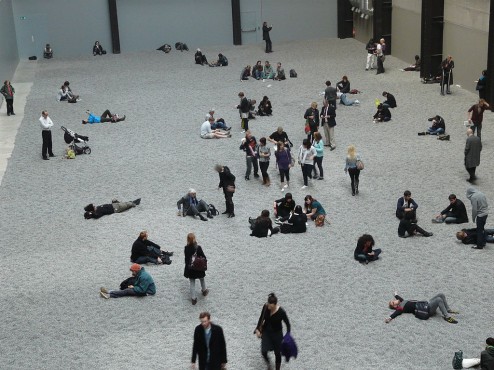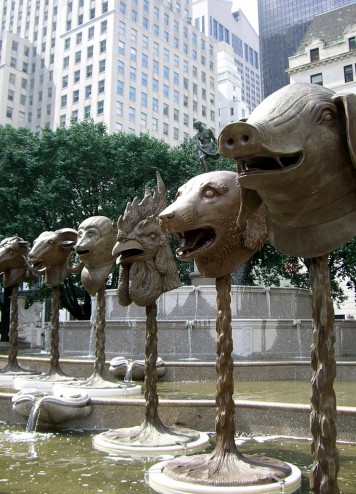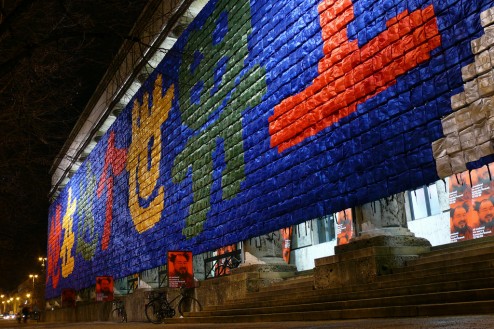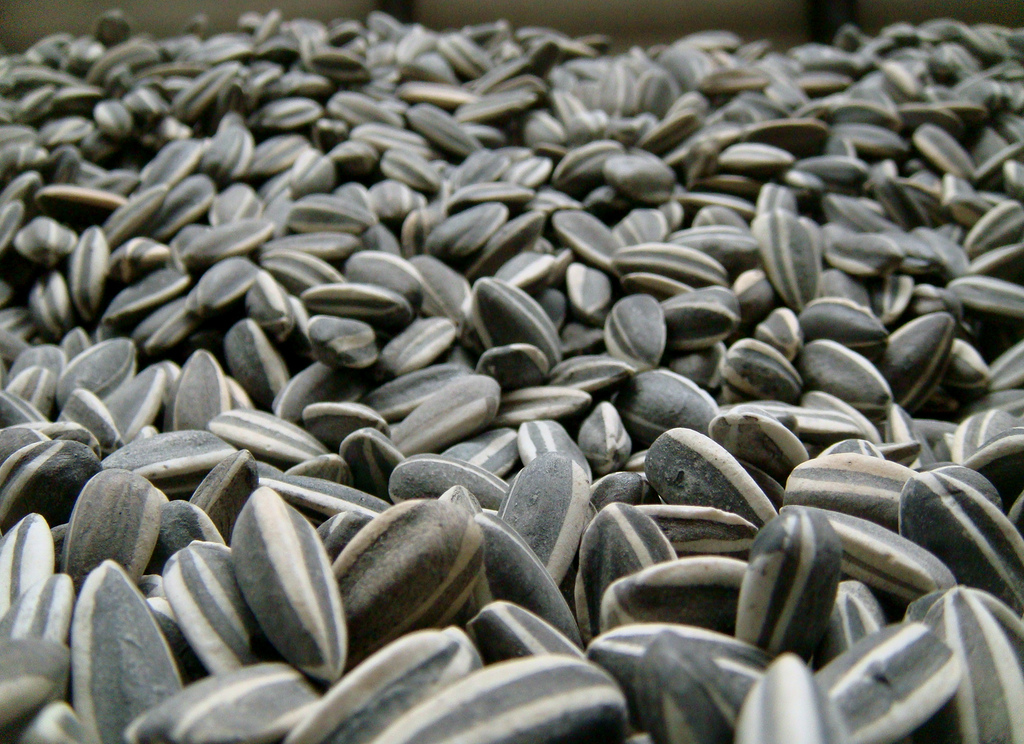One year ago today, China’s most famous artist, Ai Weiwei, was released from eighty-one days of detention with the Chinese government. Theoretically, the government will return his passport today. If they do, it is not clear if he will be able to leave the country. If he leaves, he’s not certain he’ll be able to return.
This artist lives very dangerously.
Ai Weiwei has created many works of art that are openly critical of the Chinese government. They also happen to be fascinating and beautiful.

Ai Weiwei, Sunflower Seeds, 2011, porcelain, Installation at the Tate Modern Tribune Hall, London, Photo by Loz Pycock, Creative Commons Attribution License via Wikimedia Commons.
Take, for example, his remarkable Sunflower Seeds, which is an installation made from 100 million tiny sunflower seeds that were handmade by 1,600 workers from Jingdezhen, an ancient porcelain-producing town. The Chinese title is a pun on the word “china” and each seed stands for 13 people. Mao Zedong was often represented as the sun and his followers were sunflowers. The work also references the Chinese porcelain export market, as well as famine and hunger in China, as the seeds were a staple during the Cultural Revolution when many, many Chinese citizens starved to death.

Ai Weiwei, Zodiac Heads, 2010, bronze, Installation in the Pulitzer Fountain, Grand Army Plaza, New York City, June 2011, Photo by Squish_E, Creative Commons Attribution License via Flickr.
Ai Weiwei’s Zodiac Heads/Circle of Animals was of special interest to his captors last year. It is made of twelve large bronzes of animal heads, which are reproductions of the ones made by European missionaries for the Chinese Emperor in the eighteenth century. The original sculptures were stolen by British and French troops in the nineteenth century. Two of the stolen sculptures emerged at an art auction at Christie’s in 2009. Chinese nationalists were outraged; Ai Weiwei was amused because the originals were European. In a gesture of ridicule, the artist decided to make his own version.
In 2008, after the terrible earthquake in Sichuan that killed nearly 70,000 people, Ai Weiwei became more involved in political activism because he felt that most of those deaths occurred because people were in cheap, shoddy, government-constructed buildings – many of which were schools – that collapsed easily. When the government refused to release the names of the children who died in the disaster, Ai Weiwei recruited several volunteers to interrogate government employees to get the names of the children. Ai Weiwei posted the videos of the interviews and the names of the children on his blog, which the government eventually shut down.
Soon after, in 2009, Ai Weiwei was abducted in the middle of the night and beaten by the police.
About a month later, while visiting Munich for a retrospective exhibition of his work, Ai Weiwei suffered a brain hematoma as a result of the police assault.
For the exhibition in Munich, Ai Weiwei created his powerful Remembering, a work of art made with 9,000 multicolored backpacks on the exterior of the Haus der Kunst. The backpacks created Chinese characters that repeat what the mother of a young victim of the earthquake said about her daughter, “She lived happily for seven years.”

Ai Weiwei, Remembering, 2009, nylon backpacks, Installation in the Haus der Kunst, Munich, Photo by Mar.tin, Creative Commons Attribution License via Flickr.
In October 2012, the Hirshhorn Museum in Washington D. C. will host a retrospective exhibition of the artist’s work. For this show, Ai Weiwei is making 1,000 porcelain river crabs, which in Chinese is the same as the word for harmony, a word often used in government propaganda.
Ai Wewei was quoted in the Economist from May 5th, 2012, stating, “The art always wins. Anything can happen to me, but the art will stay.”
-

-
Ai Weiwei, Sunflower Seeds, 2011, porcelain, Installation at the Tate Modern Tribune Hall, London, Photo by Marie A.-C., Creative Commons Attribution License via Flickr.
-

-
Ai Weiwei, Sunflower Seeds, 2011, porcelain, Installation at the Tate Modern Tribune Hall, London, Photo by Loz Pycock, Creative Commons Attribution License via Wikimedia Commons.
-

-
Ai Weiwei, Zodiac Heads, 2010, bronze, Installation in the Pulitzer Fountain, Grand Army Plaza, New York City, June 2011, Photo by Squish_E, Creative Commons Attribution License via Flickr.
-

-
Ai Weiwei, Remembering, 2009, nylon backpacks, Installation in the Haus der Kunst, Munich, Photo by Mar.tin, Creative Commons Attribution License via Flickr.
 Ai Weiwei, Sunflower Seeds, 2011, porcelain, Installation at the Tate Modern Tribune Hall, London, Photo by Loz Pycock, Creative Commons Attribution License via Wikimedia Commons.
Ai Weiwei, Sunflower Seeds, 2011, porcelain, Installation at the Tate Modern Tribune Hall, London, Photo by Loz Pycock, Creative Commons Attribution License via Wikimedia Commons.
 Ai Weiwei, Zodiac Heads, 2010, bronze, Installation in the Pulitzer Fountain, Grand Army Plaza, New York City, June 2011, Photo by Squish_E, Creative Commons Attribution License via Flickr.
Ai Weiwei, Zodiac Heads, 2010, bronze, Installation in the Pulitzer Fountain, Grand Army Plaza, New York City, June 2011, Photo by Squish_E, Creative Commons Attribution License via Flickr.
 Ai Weiwei, Remembering, 2009, nylon backpacks, Installation in the Haus der Kunst, Munich, Photo by Mar.tin, Creative Commons Attribution License via Flickr.
Ai Weiwei, Remembering, 2009, nylon backpacks, Installation in the Haus der Kunst, Munich, Photo by Mar.tin, Creative Commons Attribution License via Flickr.





